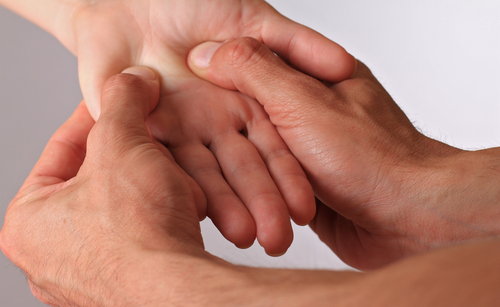A randomized, controlled clinical trial was performed to evaluate the effects of acupressure on Raynaud’s phenomenon (RP), however, no significant impact on RP symptoms was observed.
The results of the clinical trial (NCT01784354) were presented in the study “A randomized controlled trial of acupressure for the treatment of Raynaud’s phenomenon: the difficulty of conducting a trial in Raynaud’s phenomenon,” published in the Journal of Scleroderma and Related Disorders.
Constriction of blood vessels in the extremities in response to cold or emotional stress is the main cause of RP. The available treatments for the condition are not specific, with occurrence of adverse side effects, and having shown only modest benefit. Only calcium channel blockers, such as Adalat (nifedipine) or Norvasc (amlodipine), and prostacyclins, such as Flolan, are able to reduce the frequency and duration of RP attacks. This scenario has made complementary treatments, such as acupressure, a more attractive therapeutic alternative.
A previous study showed that Chinese acupuncture was beneficial for primary Raynaud’s syndrome patients, reducing the frequency of the attacks compared to controls. Still, this method requires trained professionals and can be very expensive.
Derived from acupuncture, acupressure is based on the use of pressure on key points, based on the ancient Chinese medicine meridian theory. Contrary to acupuncture, acupressure can be taught to patients and be self-administered at home.
To determine the potential benefits and applicability of standardized acupressure for improving circulation in RP, the authors of the study evaluated the frequency and duration of RP attacks, but also several indicators of disease outcome. Those indicators included RP pain, tingling and numbness, physician and patient global assessment, vessels’ function, and blood biomarkers, in either primary or secondary RP patients.
Ten patients were divided into two groups with different acupressure protocols, one focusing on the reduction of vessels constriction and the second focusing on relaxation. Six patients were included in the control group, which received an education pack provided by the Raynaud’s Association.
The authors reported a tendency for reduction of frequency and duration of attacks compared to the control group. However, no differences were found in any of the RP outcome indicators or biomarkers analyzed.
No adverse effects due to acupressure were reported, but roughly 30% of the enrolled patients dropped-out. This probably was due to the lack of efficacy or difficulty of following the daily routine of treatment.
In summary, the authors could not find any evidence to support acupressure as an effective therapeutic method for RP.
Identification of new treatments for RP has been a challenge, mainly due to the variability and lack of standardized outcome measures between clinical trials. “A standardized composite index for RP or more reliable outcome measures are needed for multi center trials,” the authors concluded.


